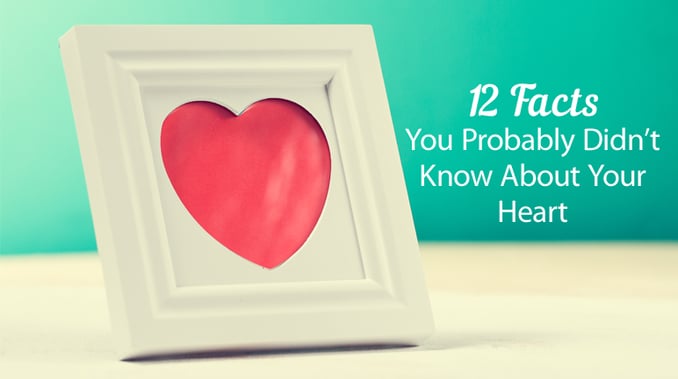
Happy heart month!
For such an important muscle, hearts are ignored all too often. Don’t you think your heart deserves some recognition for its loyal, steady beat and for supplying blood to all of your organs? We think so! The month of February is a great time to put your focus back on your heart and help yourself set goals for a heart-healthy year.
Below are a few fun and interesting facts about your heart to help you appreciate just how important your heart–and heart health–really is:
12 Fascinating Facts About Your Heart
1. Your Heart Has Its Own Rhythm
Your heart creates its own electrical impulses, allowing it to keep beating even when separated from the body (as long as it has oxygen). Pretty incredible, right?
2. A Lifetime of Beating
The average adult heart beats about 100,000 times a day. Over a lifetime, it can clock in more than 3 billion beats — a true marathoner of muscles!
3. Size Matters
Your heart is roughly the size of your fist, but its size depends on your body and its condition. A bigger body doesn’t necessarily mean a stronger heart, so taking care of it is key.
4. The #1 Health Threat
Cardiovascular disease remains the leading health risk for men and women — especially women. The good news? Most cases are preventable with proper lifestyle choices, like a balanced diet, regular exercise, and stress management.
5. Different Symptoms for Men and Women
Heart attack symptoms vary. While men often experience chest pain, women might feel unusual fatigue, dizziness, sleep disturbances, or anxiety. Not all heart attacks start with the typical warning signs, so it’s important to be aware of common symptoms and call a doctor right away if you feel like something isn’t right.
6. Exercise is Your Heart’s Best Friend
Physical inactivity is a major risk factor for heart disease. Just 150 minutes of exercise per week—like brisk walking — can lower cholesterol, reduce blood pressure, and strengthen your heart.
7. Your Heart is a Workhorse
Did you know your heart works harder than any other muscle in your body? It does the most physical work of any muscle during a lifetime. Your heart is constantly pumping energy throughout your body. Even though your heart could weaken from certain conditions, it will never fatigue.
8. It’s (Almost) Centered
From reciting the Pledge of Allegiance as a child, you might still think your heart is located on the left side of your chest. Your heart is actually located in the dead center of your chest, with the largest part of your heart on the left side. Your left lung is smaller than your right lung to make room for your heart!
9. A Faster Female Beat
A woman’s heart beats about eight times faster per minute than a man’s. Why? A smaller heart size means it needs to pump more frequently to circulate blood.
10. Sneezing Myth Debunked
You’ve probably heard that statement a few times throughout your life as an explanation for the term “bless you” after you sneeze, but experts say that is just a common myth. The changing pressure in your chest after you sneeze changes your blood flow, which could change the rhythm of your heartbeat, but it doesn’t momentarily stop it.
11. Blood Everywhere (Almost)
Your heart pumps blood to nearly every part of your body, about 75 trillion cells. The only exception? Your corneas — they get oxygen directly from the air.
12. A Pumping Powerhouse
Your heart moves an astounding 2,000 gallons of blood daily. Over a lifetime, it pumps enough to fill three supertankers. That’s a whole lot of love from one hardworking muscle!
Take These Facts to Heart
This February, give your heart the attention it deserves. Celebrate Heart Month by making small, heart-smart choices every day — whether it’s moving more, eating better, or simply appreciating the amazing work your heart does for you. After all, it’s the muscle that keeps you going, one beat at a time.
How will you celebrate your heart this month? Share your ideas and join the conversation below!
Editors Note: This post was updated in January 2025 for freshness, accuracy, and comprehensiveness.



